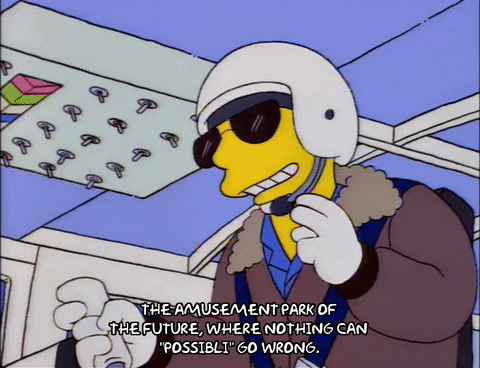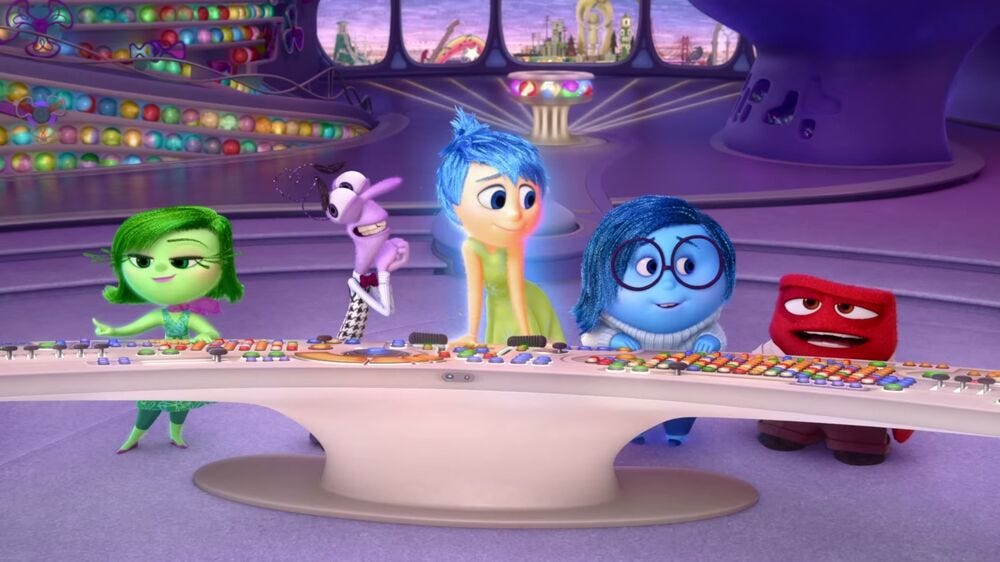Pixar's "Inside Out": How to Set Up a Story in 8 Minutes
I just rewatched Inside Out and I was impressed with the density and efficiency of the first 8 minutes. In particular, it does a remarkable job setting up the rest of the story: it sets up the story world, the core conflict, and the hero’s character arc, all while not overwhelming the audience with details.
Why is a setup important? A setup in a story is something planted for the audience which will pay off later. It creates anticipation and, when realized, delivers a feeling of satisfaction. This is often referred to as Chekhov's gun: if you show a gun in the story, it must be fired later. A set up is sometimes obvious, like ominous foreshadowing or Q’s gadgets in James Bond movies, but is often subtle like the clues in the Harry Potter mysteries.
So how does Inside Out set up the rest of the story?
The Setup for the Middle
Inside Out is a story about the inner emotions of 11-year-old Riley personified (Joy, Sadness, Anger, Disgust, Fear). The movie opens on black with a voice over "Do you ever look at someone and wonder 'what is going on inside their head?' Well, I know. I know Riley's head." With a fade in, a baby Riley is introduced before cutting back to the inside of Riley's head and introducing Joy, the story's hero, stepping out of the blackness. Joy watches baby Riley's interactions with her parents through a large, eye-shaped screen. She discovers a button on a control panel and presses it: baby Riley gurgles happily. We see Riley's parents welcome her to the world on screen. Then, a golden, glowing sphere rolls out from behind the screen, and we see it holds a memory of what we just saw on screen. Joy looks at it and places it back on its track, where it continues on and illuminates a magical, glowing machinery around Joy.
2 minutes and 30 seconds into the movie, and a remarkable amount has been established:
The perspective of the story will be told from the inside of Riley's head, looking out. In other words, inside out.
The story's hero, Joy, triggers moments of joy in Riley through a control panel.
Joy's own personality mirrors the emotions she triggers in Riley: she greets each new experience with a sense of wonder.
Memories are stored in glowing spheres which are then processed by rapidly developing machinery in Riley's head.
The room Joy is in (which we later learn to be headquarters) starts out black and reveals one new story element at a time: the story's hero, Joy; the screen through which Joy watches Riley's experiences; the control panel; the memory sphere; and the machinery. This avoids overwhelming the audience with unnecessary information, and experiencing it through Joy's perspective ensures each element is given the importance it needs.
While this is an effective introduction of an unfamiliar story world to the audience, more importantly every single element introduced is also central to the rest of the story: the control Joy has over Riley, the memory spheres, and the changing nature of Riley's mind. There are no extraneous details included and cutting anything would hurt the storytelling.
The movie continues with Joy's voice over: "It was amazing. Just Riley and me, forever..." Which, of course, leads to a reversal: baby Riley cries and Joy looks to see a new, droopy blue character pressing the button. Joy and Sadness meet for the first time, and Joy immediately tries to regain control of the button.
And now, within 3 minutes, the movie has also established the central conflict in the story: Joy struggling to—from her perspective—protect Riley from Sadness, and Joy's ego preventing her from seeing the truth that Sadness is an important and necessary emotion.
A montage follows, introducing the supporting cast of emotions while Joy explains their role in Riley's development as she ages: Fear, Disgust, and Anger. All the while, Joy jumps back into control at every opportunity. But turning back to Sadness, Joy says: "I’m not actually sure what she does."
Joy brings the audience to a wall of memory spheres and explains them to the audience, saying "and they're mostly happy... not to brag". Then, she introduces the core memories, each capturing a super-important time in Riley's life. All of Riley's core memories are a golden happy memory
These scenes further establish Joy's character, showing her ego and disdain for Sadness, while also introducing key elements of the story that follows.
A new core memory rolls in, causing a new island of personality to form in the distance. Joy explains that each core memory powers an island (Hockey Island, Goofball Island, Friendship Island, Honesty Island, Family Island), and the islands "are what make Riley... Riley!"
And while there's no immediate danger, now the audience anticipates a disruption to Joy's ordinary world and knows the stakes of the story: something will happen to the core memories, and without the core memories the islands will fail and Riley will no longer be Riley.
The montage continues, showing Joy's ordinary world and Riley's day-to-day, largely happy, life. Riley goes to sleep—Joy remarks "another perfect day!"—and they send her new memories flying into the distance to Long Term (setting up another part of the story world the audience can anticipate exploring).
Finally, the first 8 minutes also sets up Joy’s character arc: she’s in control in headquarters, and Riley is largely happy with every core memory being a happy one. Because the hero of a story is rarely static, we know this story will be about Joy’s fall—losing control and Riley becoming unhappy—and how she must grow and overcome her ego to ultimately succeed.
Joy closes with "And that’s it! We love our girl. She’s got great friends and a great house. Things couldn’t be better. After all, Riley’s 11 now. What could happen?"
And, of course, this is immediately followed by a reversal: Riley's family is moving, which is the inciting incident that sets the story into motion.
The Setup for the End
The first 8 minutes not only sets up the middle of the story—the story world, central conflict, and Joy’s character arc—but it also sets up the end. It’s common for a movie’s end to mirror the beginning to emphasize what’s changed as a result of the story. Inside Out does exactly that.
The opening scene shows Joy in control and obsessed with Riley’s memories being exclusively happy. When Anger, Fear, or Disgust take over the control panel, Joy is quick to make sure it’s temporary. And, Joy has special disdain for Sadness and limits her influence as much as possible.
The end of the movie shows a changed headquarters and a changed Joy: the upgraded control panel now allows Joy, Sadness, Anger, Fear, and Disgust to simultaneously control Riley. We see Riley in a hockey game and the seamless cooperation of the emotions. We also see Riley’s new core memories are no longer exclusively happy—instead, they are each a blend of emotions. Joy has overcome her ego and relinquished control, and a new harmony has grown in its place.
The opening ends with Joy saying:
“And that’s it! We love our girl. She’s got great friends and a great house. Things couldn’t be better. After all, Riley’s 11 now. What could happen?"
In an almost perfect mirror, the movie closes with Joy:
“We’ve been through a lot lately, that’s for sure. But we still love our girl. She has great new friends, a great new house… things couldn’t be better! After all, Riley’s 12 now. What could happen?”
This ties the end to the beginning for the audience, letting us know it’s over with a final payoff.
Conclusion
Inside Out is a case study in setups, payoffs, and efficient storytelling. And while the setups in the opening scenes lead to some predictability, the middle of the story still has plenty of surprises in exactly how it plays out.
It’s also a case study in direct storytelling: the important parts are said out loud so the audience doesn’t have to hunt for them. Instead, they know exactly what the story is about and what to expect and can enjoy watching it unfold.





